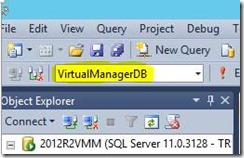How to - Nasıl yaparım Virtual Machine Manager Console Crush Problemleri yada Virtual Machine Manager da VMM cannot find VirtualHardDisk object hatası.
Event loglar:
Application Error 1000 Application Crashing Events
Faulting application name: VmmAdminUI.exe, version: 3.1.6011.0
Faulting module name: KERNELBASE.dll, version: 6.2.9200.16864
Exception code: 0xe0434352
Fault offset: 0x00010f22
Faulting process id: 0x21f0
Faulting application start time: 0x01cf9435ad93db2c
Faulting application path: C:\Program Files\Microsoft System Center 2012\Virtual Machine Manager\Bin\VmmAdminUI.exe
Faulting module path: C:\Windows\SYSTEM32\KERNELBASE.dll
Report Id:
Faulting package full name:
Faulting package-relative application ID:
Error .NET Runtime 1026 None
Application: VmmAdminUI.exe
Framework Version: v4.0.30319
Description: The process was terminated due to an unhandled exception.
Exception Info: System.ArgumentOutOfRangeException
Stack:
at System.Windows.Window.ShowDialog()
at Microsoft.VirtualManager.UI.WizardFramework.WizardWindow.ShowWizard(Microsoft.VirtualManager.UI.WpfControls.DialogOwner, Microsoft.VirtualManager.UI.WizardFramework.Flow)
at Microsoft.VirtualManager.UI.Dialogs.VMProperties.VMPropertiesLauncher.ShowDialog(Microsoft.VirtualManager.UI.Data.IClientDataContext, System.Windows.Window, Microsoft.SystemCenter.VirtualMachineManager.VMBase, Microsoft.VirtualManager.UI.Dialogs.VMProperties.VMPropertiesPage, Boolean)
at Microsoft.VirtualManager.UI.Pages.Datacenter.VMPropertiesAction.DoAction(Microsoft.VirtualManager.UI.Pages.Datacenter.IVMViewModel)
at Microsoft.VirtualManager.UI.Pages.Datacenter.VmAction.OnClick()
at Microsoft.VirtualManager.UI.ConsoleFramework.ActionBase.System.Windows.Input.ICommand.Execute(System.Object)
at MS.Internal.Commands.CommandHelpers.CriticalExecuteCommandSource(System.Windows.Input.ICommandSource, Boolean)
at System.Windows.Controls.MenuItem.InvokeClickAfterRender(System.Object)
at System.Windows.Threading.ExceptionWrapper.InternalRealCall(System.Delegate, System.Object, Int32)
at MS.Internal.Threading.ExceptionFilterHelper.TryCatchWhen(System.Object, System.Delegate, System.Object, Int32, System.Delegate)
at System.Windows.Threading.DispatcherOperation.InvokeImpl()
at System.Windows.Threading.DispatcherOperation.InvokeInSecurityContext(System.Object)
at System.Threading.ExecutionContext.RunInternal(System.Threading.ExecutionContext, System.Threading.ContextCallback, System.Object, Boolean)
at System.Threading.ExecutionContext.Run(System.Threading.ExecutionContext, System.Threading.ContextCallback, System.Object, Boolean)
at System.Threading.ExecutionContext.Run(System.Threading.ExecutionContext, System.Threading.ContextCallback, System.Object)
at System.Windows.Threading.DispatcherOperation.Invoke()
at System.Windows.Threading.Dispatcher.ProcessQueue()
at System.Windows.Threading.Dispatcher.WndProcHook(IntPtr, Int32, IntPtr, IntPtr, Boolean ByRef)
at MS.Win32.HwndWrapper.WndProc(IntPtr, Int32, IntPtr, IntPtr, Boolean ByRef)
at MS.Win32.HwndSubclass.DispatcherCallbackOperation(System.Object)
at System.Windows.Threading.ExceptionWrapper.InternalRealCall(System.Delegate, System.Object, Int32)
at MS.Internal.Threading.ExceptionFilterHelper.TryCatchWhen(System.Object, System.Delegate, System.Object, Int32, System.Delegate)
at System.Windows.Threading.Dispatcher.LegacyInvokeImpl(System.Windows.Threading.DispatcherPriority, System.TimeSpan, System.Delegate, System.Object, Int32)
at MS.Win32.HwndSubclass.SubclassWndProc(IntPtr, Int32, IntPtr, IntPtr)
at MS.Win32.UnsafeNativeMethods.DispatchMessage(System.Windows.Interop.MSG ByRef)
at System.Windows.Threading.Dispatcher.PushFrameImpl(System.Windows.Threading.DispatcherFrame)
at System.Windows.Threading.Dispatcher.PushFrame(System.Windows.Threading.DispatcherFrame)
at System.Windows.Threading.Dispatcher.Run()
at System.Windows.Application.RunDispatcher(System.Object)
at System.Windows.Application.RunInternal(System.Windows.Window)
at System.Windows.Application.Run(System.Windows.Window)
at Microsoft.VirtualManager.UI.VmmAdmin.Program.Main(System.String[])
Information Windows Error Reporting 1001 None
Fault bucket , type 0
Event Name: CLR20r3
Response: Not available
Cab Id: 0
Problem signature:
P1: vmmadminui.exe
P2: 3.1.6011.0
P3: 50ab00c1
P4: mscorlib
P5: 4.0.30319.18449
P6: 528fdb6a
P7: 24d
P8: 18
P9: System.ArgumentOutOfRange
P10:
Trace log:
0x073C,0x1BB0,16,VM.cs,1020,0x00000000,Error when trying to get VM with id . retry count 1,{00000000-0000-0000-0000-000000000000},1,
0x073C,0x1268,14,ImgLibOM.cs,101,0x00000000,VM object BRKSRV instantiated with ID lock NoLock,{00000000-0000-0000-0000-
000000000000},2,
0x073C,0x1BB0,16,VM.cs,1020,0x00000000,Microsoft.VirtualManager.Engine.ImageLibrary.VMChildObjectNotFoundException: VMM cannot find VirtualHardDisk object.
Ensure the library object is valid; and then try the operation again.
at Microsoft.VirtualManager.Engine.ImageLibrary.VM.ReadChildren(Boolean ignoreErrorLoadingChildren)
at Microsoft.VirtualManager.Engine.ImageLibrary.VM..ctor(VMData objData; CarmineObjectLock objLock; Boolean loadShallow; Boolean cloneData; Boolean ignoreErrorLoadingChildren)
at Microsoft.VirtualManager.Engine.ImageLibrary.LibraryUtils.CreateLibObject(LibObjectData objData; CarmineObjectLock objLock; Boolean loadShallow; Boolean ignoreErrorLoadingChildren)
at Microsoft.VirtualManager.Engine.ImageLibrary.LibraryUtils.GetLibObject(Guid id; CarmineObjectType objType; Guid taskID; CarmineObjectLockType lockType; Boolean loadShallow; Boolean ignoreErrorLoadingChildren)
at Microsoft.VirtualManager.Engine.ImageLibrary.VM.Get(Guid id; Guid taskID; CarmineObjectLockType lockType; Boolean shallowLoad; Boolean ignoreErrorLoadingChildren)
*** Carmine error was: LibObjectNotFound (801); 0
Virtual Machine Manager konsol crush problemi yada VMM cannot find VirtualHardDisk object <GUIDValue>hatası alıyor ve yukarıdaki semptomları yaşıyorsanız çözüm için https://support.microsoft.com/kb/2756886 makalesindeki aksiyonu uygulayabilirsiniz.
1. VMM Servisini durduralım ve VMM'in full database backup’ını alalım.
2. Microsoft SQL Server Management Studio yu açalım be VMM database’ine bağlanalım.
3. Sol üst köşeden VMM database’inin seçili olduğuna emin olalım.
4. VMM database ismi üzerinde sağ click – new query’i seçelim.
5. Aşağıdaki query’i query penceresine kopyalayıp çalıştıralım.
BEGIN TRANSACTION T1
DECLARE custom_cursor CURSOR FOR
SELECT VHDId, VDriveId from
dbo.tbl_WLC_VDrive WHERE [VHDId] NOT IN
(SELECT VHDId from dbo.tbl_WLC_VHD WHERE VHDID IS NOT NULL)
DECLARE @VHDId uniqueidentifier
DECLARE @VDriveId uniqueidentifier
OPEN custom_cursor
FETCH NEXT FROM custom_cursor INTO @VHDId, @VDriveId
WHILE(@@fetch_status = 0)
BEGIN
if(@VHDId is NOT NULL)
DELETE FROM dbo.tbl_WLC_VDrive
WHERE VDriveId = @VDriveId
FETCH NEXT FROM custom_cursor INTO @VHDId, @VDriveId
END
CLOSE custom_cursor
DEALLOCATE custom_cursor
COMMIT TRANSACTION T1
6. VMM servisini start edelim.
Burak FİLİZ
Technorati Tags: VMM,SCVMM,SCVMM 2012,How to,Nasıl yaparım
